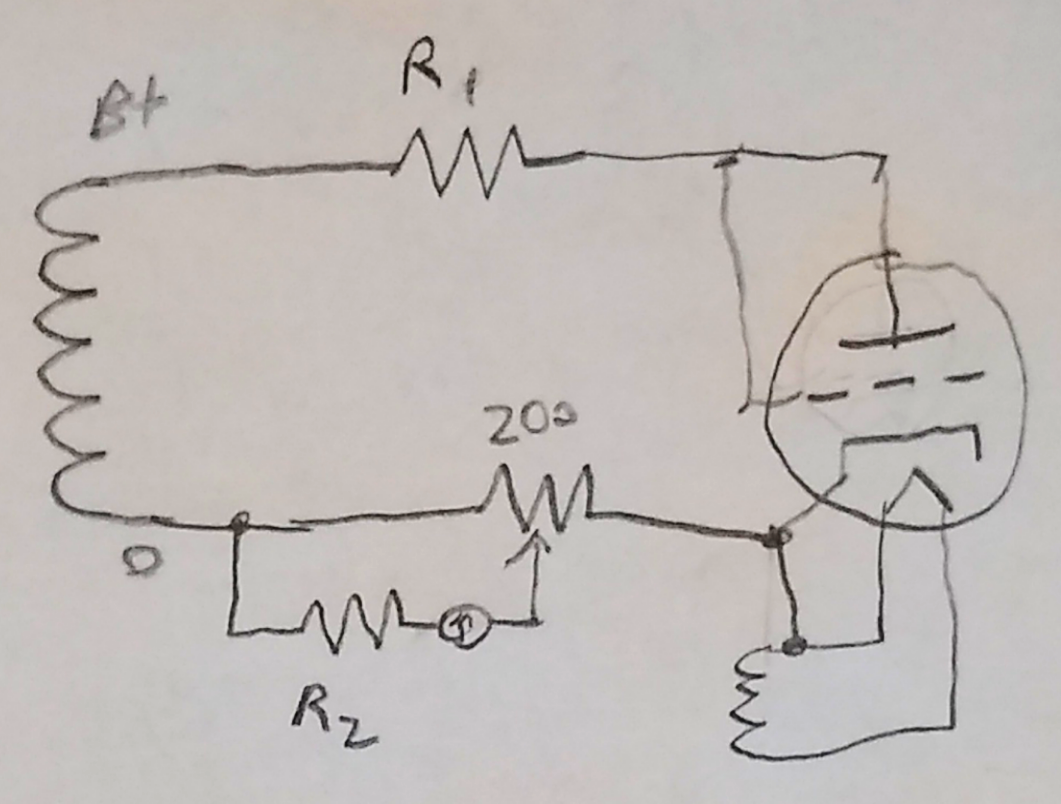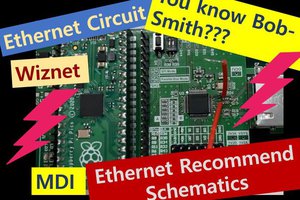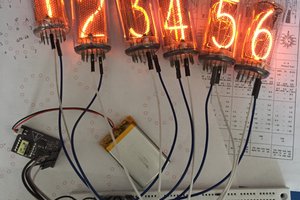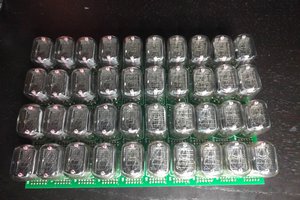Testing vacuum tubes without a tester
Short, leakage and emission testing with just basic tools
Short, leakage and emission testing with just basic tools
To make the experience fit your profile, pick a username and tell us what interests you.
We found and based on your interests.
Heathkit-IT-21-tube data.pdfTube setting chartsAdobe Portable Document Format - 2.08 MB - 06/17/2022 at 18:47 |
|
|
Heathkit it-17 tube tester.pdfIT-17 manual and schematics. Single page schematics.Adobe Portable Document Format - 836.13 kB - 06/17/2022 at 18:46 |
|
|
Heathkit IT-21 tube tester.pdfIT-21 assembly, manual, schematics. Better build instructions, but schematics are split between pages.Adobe Portable Document Format - 1.67 MB - 06/17/2022 at 18:45 |
|
|
Let's test some 6DJ8's in order to sort out the meter resistance.
Here's the data collected in prior log. This is a dual triode
Pinout:
| 1 | A | Plate 1 |
| 2 | B | Grid 1 |
| 3 | C | Cathode 1 |
| 4 | D | Heater |
| 5 | E | Heater |
| 6 | F | Plate 2 |
| 7 | G | Grid 2 |
| 8 | H | Cathode 2 |
| 9 | J | Shield |
The letters correspond to how the tester refers to the pins.
The tube data lists these values:
| Element 1 | Element 2 | |
| Type | 2 | 2 |
| Filament | 6.3 | 6.3 |
| Plate | 21 | 21 |
| Top (Plate) | AB | FG |
| Bottom (Cathode/Filament) | C(E) | (E)H |
Type 2 means, a B+ of 30v, plate R of 820 ohm and meter R of 360.
Test circuit
In order to test, I'll take the fact that the meter+R2 much higher than the 40ohm of the pot, and omit it initially.
With this, I'll use the 200ohm pot connected from power supply negative to cathode, and 820 ohm set on 10W decade resistance boxes from plate(plus grid) to the power supply positive. Then we'll be able to measure a voltage across the power supply negative and pot wiper.
With a 200ohm pot value of 21/100, this means 42ohm from low to wiper.
Measuring that voltage represents the voltage across R2 and the meter resistance. Knowing that a good value results in 0.5mA, we can calculate the total resistance.
Each line represents a different tube, measuring that voltage, along with the current through the circuit. This is just from the simplified circuit for the emission test. (Not open, leakage or short tests)
| Test | E1 V | E1 plate I | E2 V | E2 plate I |
| 1 | 1.00 | 23.8 | 1.03 | 24.6 |
| 2 | 1.05 | 25.1 | 1.04 | 24.8 |
| 3 | 1.07 | 25.5 | 1.04 | 24.8 |
| 4 | 1.04 | 24.8 | 0.88 | 20.9 |
| 5 | 1.02 | 24.4 | 1.04 | 24.8 |
| 6 | 1.06 | 25.2 | 1.07 | 25.4 |
| 7 | 1.06 | 25.3 | 1.06 | 25.3 |
| 8 | 1.05 | 25.0 | 1.07 | 25.4 |
I'd prepared to test more, but stopped after 8 because things were so clear. There's even a failure of element 2 in number 4.
One surprise is that the current is so high. The 6DJ8 is specified at 27mA max, with 15 typ.
That the voltage comes out to just over 1V doesn't seem like a coincidence.
If we take 1v as passing (above 0.5mA, this means the resistance needs to be less than R = V/I = 1/0.0005 = 2000. Removing the selected series R we get a meter resistance of 1640 ohm.
If the meter were actually 1.5K, then the resulting current would be 1/1860 = 0.54mA, which seems like it may be in the good territory on the display.
If the meter were actually 1K, then the resulting current would be 0.74mA, right in the middle of the good side. (I notice that in the instructions for testing new tube types, it indicates a be default reading right in the middle of good, so 0.74mA makes sense)
Looking at the triode with an off value, with a 1K meter, it would be 0.64mA, probably reading good. With a 1.5K meter, it would be 0.47mA, probably in the bad territory.
Seems like we've narrowed it down in that 1 or 1.5K region. Given that, we can confirm that omitting it from the circuit was reasonable, reflecting only a 2 ohm difference. At 1% of full scale, i can tell you on this pot, that this is well within tolerance of manual setting of the pot.
This all seems to suggest to me that about 1.0V is that passing target.
With a little uncertainty about the threshold and test current, it think I need to test another model of tube, with different settings.
I have a set of tubes to test for an amplifier. I'll go through them.
First is the rectifier/dual diode used in power supply.
Pinout:
| 1 | A | NC |
| 2 | B | Heater 1 |
| 3 | C | (Missing) |
| 4 | D | Plate 1 |
| 5 | E | (Missing) |
| 6 | F | Plate 2 |
| 7 | G | (Missing) |
| 8 | H | Heater 2 / Cathode |
The letters correspond to how the tester refers to the pins.
The tube data lists these values:
| Element 1 | Element 2 | |
| Type | 3 | 3 |
| Filament | 5 | 5 |
| Plate | 25 | 25 |
| Top (Plate) | F | D |
| Bottom (Cathode/Filament) | (H) | (H) |
Not listed in there, but all other switches are middle, which is connected to the other side of the filament voltage, "positive".
Type 3 means, a B+ of 30v, plate R of 0 ohm and meter R of 1500.
A dual triode, used in preamp and phase inverter.
Pinout:
| 1 | A | Grid 2 |
| 2 | B | Plate 2 |
| 3 | C | Cathode 2 |
| 4 | D | Grid 1 |
| 5 | E | Plate 1 |
| 6 | F | Cathode 1 |
| 7 | G | Heater 1 |
| 8 | H | Heater 2 |
The tube data lists these values:
| Element 1 | Element 2 | |
| Type | 2 | 2 |
| Filament | 6.3 | 6.3 |
| Plate | 26 | 26 |
| Top (Plate) | DE | AB |
| Bottom (Cathode/Filament) | (F)(G) | C(G) |
Not listed in there, but all other switches are middle, which is connected to the other side of the filament voltage, "positive". It's puzzling that F is bolded, but not C. Seems like F shouldn't be.
Type 2 means, a B+ of 30v, plate R of 820 ohm and meter R of 360
A beam pentode used as output drivers.
The catch here is that with the tubes I have, no markings are visible. The version w3 schematics these are marked as 5881, but the tube shape doesn't seem right, and doesn't match the pictures. Other sources suggest they could be 6L6. So I'll look up values for both and we can see what it looks like.
Pinout:
| 1 | A | Shell / NC |
| 2 | B | Heater |
| 3 | C | Plate |
| 4 | D | Grid 2 (screen) |
| 5 | E | Grid 1 |
| 6 | F | (Missing) |
| 7 | G | Heater |
| 8 | H | Cathode / Grid 3 |
Both 5881 and 6L6 share the same pinout, so that's a good start.
The tube data lists these values:
| 6L6 | 5881 | |
| Type | 3 | 3 |
| Filament | 6.3 | 6.3 |
| Plate | 27 | 20 |
| Top (Plate) | CDE | CDE |
| Bottom (Cathode/Filament) | (G)H | (B)H |
Not listed in there, but all other switches are middle, which is connected to the other side of the filament voltage, "positive". It's interesting that the only pinout difference here is the "polarity" of the filament, which wouldn't seem to matter.
Type 3 means, a B+ of 30v, plate R of 0 ohm and meter R of 1500.
As we still have one missing value from the circuit, I'm going to use a reference tube that I have a lot of, in this case a set of Amperex 6DJ8/ECC88 's. While these are all used, my hope is that by testing a bunch, I can find a common value and build certainty with that
This is a dual triode
Pinout:
| 1 | A | Plate 1 |
| 2 | B | Grid 1 |
| 3 | C | Cathode 1 |
| 4 | D | Heater |
| 5 | E | Heater |
| 6 | F | Plate 2 |
| 7 | G | Grid 2 |
| 8 | H | Cathode 2 |
| 9 | J | Shield |
The letters correspond to how the tester refers to the pins.
The tube data lists these values:
| Element 1 | Element 2 | |
| Type | 2 | 2 |
| Filament | 6.3 | 6.3 |
| Plate | 21 | 21 |
| Top (Plate) | AB | FG |
| Bottom (Cathode/Filament) | C(E) | (E)H |
Not listed in there, but all other switches are middle, which is connected to the other side of the filament voltage, "positive". The bolding didn't make sense, so I updated here to be what I think it is
Type 2 means, a B+ of 30v, plate R of 820 ohm and meter R of 360.
We can use all of that, distilled down to the basics to do the test without all the switches and sockets.
The generic test circuit is:

Note that if the device is a pentode or pentagrid converter, all the grids are weird together with the plate.
| Type | B+ | R1 | R2 |
| 1 | 30 | 3600 | 0 |
| 2 | 30 | 820 | 360 |
| 3 | 30 | 0 | 1500 |
| 4 | 250 | 2500 | 1500 |
Looks like R1 could burn some power, so probably best to keep the test short if you can't find 10w ones.
I'll also need a 200 ohm wire wound resistor which I found. If you don't have one, you could use a decade resistor box, or substitute in fixed values. Looks like whatever you pick should be able to tolerate 25mA, or 1.25W (modes 1,2,3 only), which should only happen if the tube has a short.
The original tester uses AC for the supply, relying on the tube as a diode, and the averaging nature of an analog meter to smooth out the pulses. I'll just use DC, which also makes for easy current limiting. I think you can use AC with a digital ammeter, as long as you set it to ac RMS.
We still need to figure out the meter resistance, which we'll get to soon.
Vacuum tube testers present themselves as rather mysterious. You plug in a tube, look up some esoteric numbers, set some knobs, flip switches back and forth and watch a meter which is simply labeled with a fail to pass gradient, without any units or other info. So what is it doing and how does it work?
Thankfully, there are lots of reference designs out there with documentation. Perhaps the easiest to find are the Heathkit models. These were sold as kits to hobbyists to assemble themselves. Their instructions include schematics, BOMs and some theory information. Digging around shows that all the common versions use basically the same circuit, with some minor variations. I'll look at the IT-17 and IT-21 models.
The manuals outline the types of tube testing. I'll let you read them directly for more details, but the key take away is that these are like most common tube testers, which test for shorts, Leakage, Opens, and Emission (which covers filament as well)
HeathKit IT-17 This scan has easier to read schematics, but doesn't include the full assembly instructions.
HeathKit IT-21 This scan has the full assembly, but the fold out schematics are split between pages.
Images in this post are from these files.
Buried into the details is a note that the short test checks for connections between pins that are less than 250Kohm and leakage check is for less than 2Mohm. So the word "short" is a little loose. Anyway, the simplified circuit for this:
This uses a 100V test voltage across pairs of pins, with a series neon bulb (there is also an R not shown) to test for shorts. If the neon illuminates, it means there is a resistance below a certain level(250k/2M). A neon is used here because it takes very little current. Switches are used to change which of the pins the circuit is connected to. This is why during a short test, you are flipping the switches back and forth, to get all the combinations. Given the wide range of number of tube pins supported, it explains why there are so many switches on the tester. (13 for this model)
To test emission, the meter is used, along with a setting on the pot to check that the right amount of current is flowing from cathode to plate. But for those familiar with curve tracers, where is the seting for the grid(base/gate)? Digging through the theory section, we find that the common emission type tester doesn't test it as a 3/4/5 terminal device, instead wiring it as a 2 terminal diode. Here's the simplified circuit:
The switches are shown in the position for testing emission. You can see the filament is being run as normal, and the meter is measuring cathode current, while the plate and grid(s) are connected to the voltage source. Not shown are the series resistors, or selection of plate voltage and resistor
The pot acts like a range switch on a multimeter, more on this later.
But how do you measure opens, when most of the elements are open by design within the vacuum? The answer is to see if the emission test changes based on which elements are acting like the plate.
By connecting all the elements(besides cathode and heater) together and high, they are all acting like the plate. Obviously a grid isn't going to be very effective compared to the actual plate, but it has an effect. The emission test is run, and one at a time, each element is disconnected. With each disconnect, the cathode current(shown on meter) should change somewhat. When each is disconnected, that element is removed from the larger effective plate, changing the value. The instructions tell the user to look for any movement of the needle, no matter how small. If the meter doesn't move at all, it means that element is already disconnected.
In this way, we can check for opens on the plate and each...
Read more »
Create an account to leave a comment. Already have an account? Log In.
Become a member to follow this project and never miss any updates

 Alan
Alan
 Paul Andrews
Paul Andrews
 robert.c.baruch
robert.c.baruch
 Greg Duckworth
Greg Duckworth